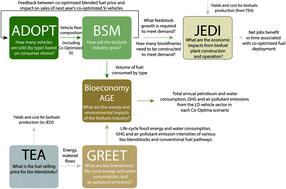当前位置:
X-MOL 学术
›
Energy Environ. Sci.
›
论文详情
Our official English website, www.x-mol.net, welcomes your
feedback! (Note: you will need to create a separate account there.)
Energy, economic, and environmental benefits assessment of co-optimized engines and bio-blendstocks
Energy & Environmental Science ( IF 32.4 ) Pub Date : 2020-06-18 , DOI: 10.1039/d0ee00716a Jennifer B. Dunn 1, 2, 3 , Emily Newes 3, 4, 5 , Hao Cai 1, 2, 3 , Yimin Zhang 3, 4, 5 , Aaron Brooker 3, 4, 5 , Longwen Ou 1, 2, 3 , Nicole Mundt 3, 4, 5 , Arpit Bhatt 3, 4, 5 , Steve Peterson 3, 6, 7 , Mary Biddy 3, 4, 5
Energy & Environmental Science ( IF 32.4 ) Pub Date : 2020-06-18 , DOI: 10.1039/d0ee00716a Jennifer B. Dunn 1, 2, 3 , Emily Newes 3, 4, 5 , Hao Cai 1, 2, 3 , Yimin Zhang 3, 4, 5 , Aaron Brooker 3, 4, 5 , Longwen Ou 1, 2, 3 , Nicole Mundt 3, 4, 5 , Arpit Bhatt 3, 4, 5 , Steve Peterson 3, 6, 7 , Mary Biddy 3, 4, 5
Affiliation

|
Advances in fuel and engine design that improve engine efficiency could lower the total cost of vehicle ownership for consumers, support economic development, and offer environmental benefits. Two fuel properties that can enhance the efficiency of boosted spark ignition engines are research octane number and octane sensitivity. Biomass feedstocks can produce fuel blendstocks with these properties. Correspondingly, using a suite of models, we evaluated the change in energy and water consumption and greenhouse gas and air pollutant emissions in the light duty fleet from 2025 to 2050 when bio-blendstocks isopropanol, a methylfuran mixture, and ethanol are blended at 31%, 14%, and 17%, respectively, with petroleum. These blended fuels increase engine efficiency by 10% when used with a co-optimized engine. In these scenarios, we estimated that petroleum consumption would decrease by between 5–9% in 2050 alone and likely by similar levels in future years as compared to a business as usual case defined by energy information administration projections. Overall, between 2025 and 2050, we determined that, when isopropanol is the bio-blendstock, GHG emissions, water consumption, and PM2.5 emission cumulative reductions could range from 4–7%, 3–4%, and 3%, respectively. Cumulative reductions would continue to increase beyond 2025 as the technology would gain an increasing foothold, indicating the importance of allowing time for technology penetration to achieve desired benefits. Annual jobs increased between 0.2 and 1.7 million in the case in which isopropanol was the bio-blendstock. Overall, this analysis provides a framework for evaluating the benefits of deploying co-optimized fuels and engines considering multiple energy, environmental, and economic factors.
中文翻译:

共同优化的发动机和生物混合原料的能源,经济和环境效益评估
燃料和发动机设计的进步可以提高发动机效率,可以降低消费者购置汽车的总成本,支持经济发展并带来环境效益。研究辛烷值和辛烷值敏感性的两个可以提高增压火花点火发动机效率的燃料特性。生物质原料可以生产具有这些特性的燃料混合原料。相应地,我们使用一组模型评估了2025年至2050年轻质车队中生物掺混料异丙醇,甲基呋喃混合物和乙醇的混合比例为31%时的能源和水消耗以及温室气体和空气污染物排放的变化,石油分别占14%和17%。当与共同优化的发动机一起使用时,这些混合燃料可将发动机效率提高10%。在这些情况下,我们估计,仅能源消耗一项就可以在2050年减少5–9%,并且与能源信息管理部门预测的“通常情况”相比,未来几年的石油消费可能会以类似的水平下降。总体而言,在2025年至2050年之间,我们确定,当异丙醇是生物混合物时,GHG排放量,水消耗量和PM2.5排放量的累计减少量分别为4–7%,3–4%和3%。随着该技术的立足点越来越多,累积减少量将继续增加,直到2025年为止,这表明留出时间让技术渗透以实现期望的收益非常重要。以异丙醇为生物混合物的情况下,年工作机会增加了0.2到170万。总体而言,该分析提供了一个框架,该框架评估了在考虑多种能源,环境和经济因素的情况下部署共同优化的燃料和发动机的收益。
更新日期:2020-08-14
中文翻译:

共同优化的发动机和生物混合原料的能源,经济和环境效益评估
燃料和发动机设计的进步可以提高发动机效率,可以降低消费者购置汽车的总成本,支持经济发展并带来环境效益。研究辛烷值和辛烷值敏感性的两个可以提高增压火花点火发动机效率的燃料特性。生物质原料可以生产具有这些特性的燃料混合原料。相应地,我们使用一组模型评估了2025年至2050年轻质车队中生物掺混料异丙醇,甲基呋喃混合物和乙醇的混合比例为31%时的能源和水消耗以及温室气体和空气污染物排放的变化,石油分别占14%和17%。当与共同优化的发动机一起使用时,这些混合燃料可将发动机效率提高10%。在这些情况下,我们估计,仅能源消耗一项就可以在2050年减少5–9%,并且与能源信息管理部门预测的“通常情况”相比,未来几年的石油消费可能会以类似的水平下降。总体而言,在2025年至2050年之间,我们确定,当异丙醇是生物混合物时,GHG排放量,水消耗量和PM2.5排放量的累计减少量分别为4–7%,3–4%和3%。随着该技术的立足点越来越多,累积减少量将继续增加,直到2025年为止,这表明留出时间让技术渗透以实现期望的收益非常重要。以异丙醇为生物混合物的情况下,年工作机会增加了0.2到170万。总体而言,该分析提供了一个框架,该框架评估了在考虑多种能源,环境和经济因素的情况下部署共同优化的燃料和发动机的收益。











































 京公网安备 11010802027423号
京公网安备 11010802027423号